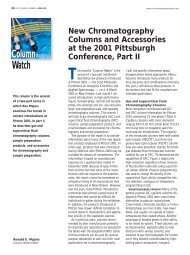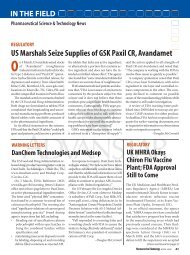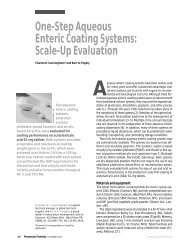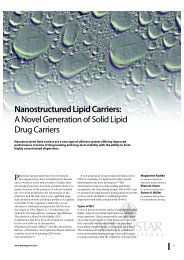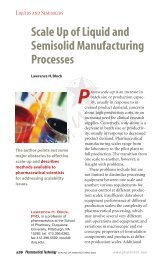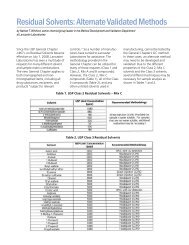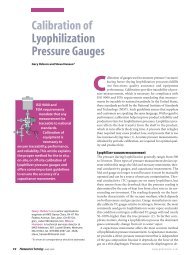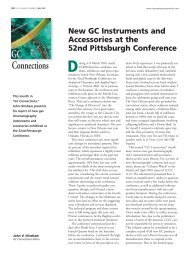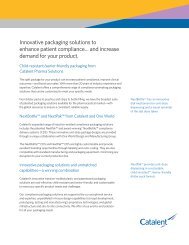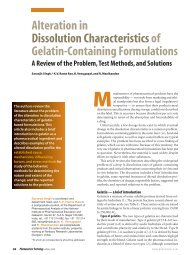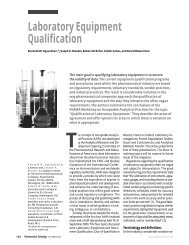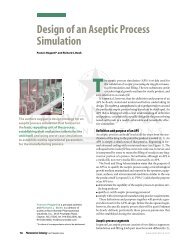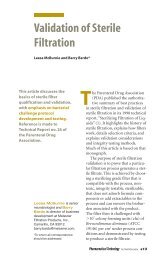Autosamplers - Chromatography Online
Autosamplers - Chromatography Online
Autosamplers - Chromatography Online
Create successful ePaper yourself
Turn your PDF publications into a flip-book with our unique Google optimized e-Paper software.
1236 LCGC VOLUME 18 NUMBER 12 DECEMBER 2000 www.chromatographyonline.com<br />
into the barrel and then inject it by<br />
mechanical force. Back-loading autosamplers<br />
use gas pressure to push liquid from the<br />
sample vial or solvent reservoir through<br />
connecting tubing into the syringe barrel<br />
and then out the needle, always moving the<br />
liquid in the same direction. Hybrid<br />
autosamplers combine the sampling method<br />
of a front-loading autosampler with the solvent<br />
rinsing of a back-loading autosampler.<br />
In either case, a clean and relatively<br />
low–viscosity liquid sample will produce<br />
the best results. Dirty or highly viscous<br />
samples are problematic for reasons that I<br />
will discuss below.<br />
Front-loading autosamplers: In frontloading<br />
autosamplers, the syringe moves<br />
into positions over the sample vial, solvent<br />
reservoirs, the inlet, and waste receptacles,<br />
as Figure 1 shows, and then deposits or<br />
removes liquid as required. The amount of<br />
liquid consumed is small, so these autosamplers<br />
can successfully handle samples of<br />
100 L or less. Only the syringe needle,<br />
barrel, and plunger contact the sample<br />
before injection, and this minimized contact<br />
reduces the amount of solvent needed<br />
to clean the syringes between samples and<br />
the levels of sample-to-sample carryover in<br />
normal operation.<br />
Plunger<br />
motion<br />
Syringe<br />
motion<br />
Inlet<br />
Sample<br />
Solvent<br />
Waste<br />
Figure 1: In a front-loading autosampler<br />
sample, solvent, or waste vials are positioned<br />
beneath the syringe, and the syringe moves<br />
from vial loading to injection positions. The<br />
syringe plunger moves up and down to pump<br />
and eject liquid from the syringe.<br />
Sample acquisition into the syringe barrel<br />
depends upon efficient plunger suction; a<br />
leaking or worn syringe will cause problems<br />
with reproducibility and sample-to-sample<br />
carryover. Sample cleanliness is paramount<br />
because small amounts of particulate matter<br />
will wear out the syringe plunger rapidly,<br />
and nonvolatile residues can cause the<br />
plunger actuation force to increase and<br />
eventually stick the plunger firmly in place.<br />
In front-loading devices, the syringe<br />
plunger goes through many more actuations<br />
per sample injection — approximately<br />
16–20 — than in back-loading devices.<br />
That’s roughly 2000 actuations per full<br />
autosampler tray or 10,000 actuations per<br />
five-day workweek at one tray per day. For<br />
these reasons, most workers prefer polytetrafluoroethylene<br />
(PTFE)–tipped syringe<br />
plungers in front-loading autosamplers.<br />
A too-volatile solvent, such as diethyl<br />
ether or methylene chloride (with atmospheric<br />
pressure boiling points of 34 °C<br />
and 40 °C, respectively) will boil easily<br />
under the reduced pressure conditions<br />
inside the syringe barrel and needle during<br />
plunger motion. The resulting bubbles seriously<br />
detract from accuracy and reproducibility.<br />
Even with autosampler tray cooling<br />
to minimize sample temperatures,<br />
hexane probably is the most volatile solvent<br />
that chromatographers can use successfully<br />
and consistently.<br />
Back-loading autosamplers: In a backloading<br />
autosampler, a second dedicated<br />
sampling needle removes liquid from the<br />
sample vials and solvent reservoirs. Instead<br />
of depending upon syringe plunger suction,<br />
gas pressure positively displaces sample<br />
from the solvent or sample containers<br />
through the second needle and connecting<br />
tubing, into the rear or top of the microsyringe<br />
itself. Liquid flows through the<br />
microsyringe and into waste receptacles<br />
during washing or sample acquisition. The<br />
plunger acts as a two-way valve in this case.<br />
When the plunger is in the up position, as<br />
Figure 2 shows, liquid can travel from the<br />
connecting tubing into the syringe and<br />
downward into a waste receptacle. This<br />
type of arrangement can flush the syringe<br />
very efficiently, but it also consumes more<br />
sample and solvent volume than a frontloading<br />
device. For injection, sample fills<br />
the syringe, the plunger moves into position<br />
at the programmed volume set point,<br />
and the syringe then injects the sample into<br />
the inlet.<br />
A back-loading device also is susceptible<br />
to contaminated samples. Small particles<br />
can clog the interconnecting tubing, and<br />
nonvolatile residue deposits can cause the<br />
plunger actuation force to increase to the<br />
point of stalling as well. However, unlike a<br />
front-loading device, only a few syringe<br />
plunger actuations occur per injection, so<br />
the syringes tend to last longer. Finally,<br />
back-loading devices better tolerate morevolatile<br />
solvents because the system remains<br />
under positive pressure during sample<br />
transport. However, the rapid changes in<br />
internal pressure that occur during sampling<br />
at temperatures close to the liquid’s<br />
boiling point sometimes cause bubble formation<br />
because of the release of entrained<br />
gas from the liquid at nucleation points<br />
along the tubing and connections.<br />
Hybrid autosamplers: Hybrid autosamplers<br />
that mix features of both front- and<br />
back-loading systems also are possible.<br />
These devices load the sample through the<br />
syringe needle, as does a front-loading<br />
system, and rinses the syringe from a larger<br />
solvent reservoir, as does a back-loading<br />
system, as shown in Figure 2. This fusion<br />
of the two operational modes blends the<br />
low carryover and sample consumption<br />
Plunger<br />
motion<br />
Syringe<br />
motion<br />
Inlet<br />
Waste<br />
Load<br />
position<br />
Sample<br />
Solvent or<br />
sample flow<br />
Gas input<br />
Solvent<br />
Figure 2: In a back-loading or hybrid autosampler<br />
the sampling needle (right) enters sample<br />
or solvent vials and gas pressure forces liquid<br />
through the syringe and into a waste vial.<br />
For injection, the plunger moves down to set<br />
the amount of sample and then the syringe<br />
moves over the inlet. In a hybrid autosampler,<br />
the sample vial is positioned under the syringe<br />
needle.



